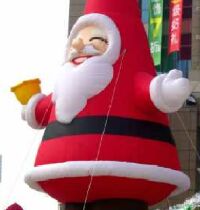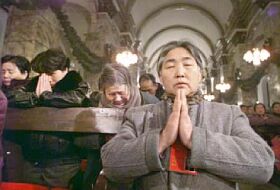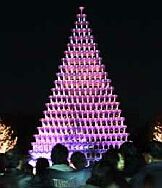|
  East Asia East Asia 
China
China is in the eastern part of Asia, bordering the East China Sea,
Korea Bay, Yellow Sea, and South China Sea, between North Korea and
Vietnam.
 Christians in
China celebrate by lighting their houses with beautiful paper lanterns
and decorating their Christmas trees, which they call "Trees of
Light," with paper chains, paper flowers, and paper lanterns.
Department stores advertise the season with Santa figures that reach
three and four stories high.
Christians in
China celebrate by lighting their houses with beautiful paper lanterns
and decorating their Christmas trees, which they call "Trees of
Light," with paper chains, paper flowers, and paper lanterns.
Department stores advertise the season with Santa figures that reach
three and four stories high.
Chinese Children hang muslin stockings and await a visit from Santa
Claus, whom they call Dun Che Lao Ren (dwyn-chuh-lau-oh-run)
which means "Christmas Old Man."
 There are an
estimated four million people in China who are Christian. This is a very
small percentage compared to the overall population of the nation. They
worship at small churches and in huge cathedrals such as the Nantang
Cathedral in Beijing shown here. There are an
estimated four million people in China who are Christian. This is a very
small percentage compared to the overall population of the nation. They
worship at small churches and in huge cathedrals such as the Nantang
Cathedral in Beijing shown here.
Christian missionaries first arrived in in Xian, the ancient capital
and cradle of Chinese civilization, in 625.
In 1999, a nativity scene, made from wood and plaster circa A.D. 780,
was found on a shadowy wall of a crumbling 1,200-year-old pagoda on the
windswept hillside of a Tao monastery near the ancient capital city.
The nativity scene combines Chinese landscape imagery with the
reclining figure of the Madonna, according to Martin Palmer, the British
scholar who found it. While badly eroded, the towering wall sculpture is
clearly not a Chinese creation but a fascinating meld of Eastern and
Western spirituality.
Since the vast majority of the Chinese people are not Christian, the
main winter festival in China is the Chinese New Year which takes place
toward the end of January. Now officially called the "Spring
Festival," it is a time when children receive new clothing, eat
luxurious meals, receive new toys, and enjoy firecracker displays.
An important aspect of the New Year celebration is the worship of
ancestors. Portraits and paintings of ancestors are brought out and hung
in the main room of the home.
Japan is an east Asian island chain between the North Pacific Ocean
and the Sea of Japan, east of the Korean Peninsula.
Free
Christmas Wallpapers and Screensavers
Japan
 There is no
official celebration of Christmas in Japan as less than one percent of
the population is Christian. There is an unofficial widespread secular
observance of Christmas due to the influence of Americans after the war
and Japan's Christmas industry that provides decorations and trinkets
for Christian nations.
There is no
official celebration of Christmas in Japan as less than one percent of
the population is Christian. There is an unofficial widespread secular
observance of Christmas due to the influence of Americans after the war
and Japan's Christmas industry that provides decorations and trinkets
for Christian nations.
As the Christmas industry grew, it was natural for the Japanese to
become interested in the Christian celebration and to absorb some of the
customs into their own society including a Christmas tree and turkey
with all the trimmings.
The trees are decorated with small toys, dolls, ornaments, gold paper
fans, lanterns, and even wind chimes. Candles are also placed on the
branches. One of the most popular ornaments is the origami swan.
Hoteiosho, one of the gods from the Japanese pantheon, brings the
gifts. Since he has eyes in the back of his head, it's natural for him
to observe the behavior of the children in Japan.
One Japanese tradition that is a boon to the baking industry is the
Christmas Cake. People purchase them since it is not normally a home
project.
The Daiku, or "Great Nine, refers to Beethoven's
"Ninth Symphony." This is traditionally performed in many
places in Japan during the Christmas and New Year Season.
 In Tokyo, unusual
decorations are often created such as this 14-foot tall tree made from
3,795 champagne glasses. It's illuminated from within and the colors
light up the night. In Tokyo, unusual
decorations are often created such as this 14-foot tall tree made from
3,795 champagne glasses. It's illuminated from within and the colors
light up the night.
Christmas is often a time for adults to indulge in heavy-duty
consumption. Christmas Eve is considered by many to be a prime time of
the year for buying diamonds and other jewelery to give to a romantic
partner.
On December 26, the decorations are taken down and the Japanese
prepare for the fast-approaching New Year's holiday. New Year's Eve is
the day to thoroughly clean the house and to dress in your finest
clothes. New Year's decorations are usually fashioned from bamboo and
pine. The kadomatsu, or gate pine, is placed at the front
entrance and the main emphasis of the season is new beginnings. The New
Year festivities continue until January 3.
Free
Christmas Wallpapers and Screensavers
 Let
Us Spread The Christmas Spirit Let
Us Spread The Christmas Spirit
|